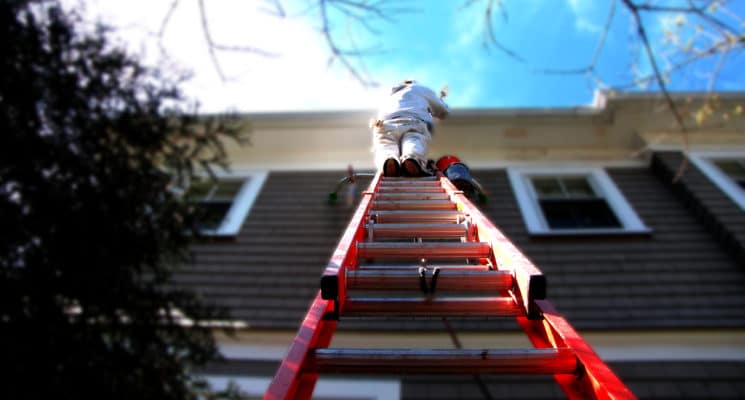
5 Common Home Repairs To Complete Before Repainting Your Home
Throughout the year, the surfaces of your home both interior and exterior will get damaged from a wide range of environmental and human factors.
For instance, exterior siding contends with sunlight, rain, and snow, which can lead to peeling paint, wood rot, and other issues. Interior walls may develop problems such as holes, cracked plaster, and water damage on ceilings.
Over time these damages will get worse and impact the look and value of your home. Before any exterior painting or interior painting project is tackled, homeowners must address any underlying home repair issues. With proper preparation, repair, and painting, homeowners can maintain their home’s look, value, and structural integrity.
Top 5 Home Painting Repairs.
This blog will address 5 of the most common home repairs a painting contractor or homeowner might encounter when it’s time for a new coat of paint.
In the painting businesses, there are many ways to approach different home repairs and methods of operation. In the following examples, we have found these procedures to work best for our company, H.D.F. Painting.
1. Repairing Rotted Wood with Abatron Epoxy.
Tools & Materials Required
- Abatron Wood Restoration Kit
- Gloves
- Putty Knife
- Mix and Measure Cups
- Stirring Stick
- Acetone
The first question is when to repair and when to replace rotted wood. Our general rule of thumb is any rot area 6 inches or less can be repaired with epoxy. Anything larger needs replacement with wood or a composite. Our epoxy of choice is Abatron. A dual system, two-part epoxy that restores rotten and decayed wood. It is a two-in-one system, that works wonders. Watch the view below to learn how to easily repair wood rot.
2. Repairing Peeling Paint.
Tools & Materials Required
- Scraper
- Drop Cloth
- Putty Knife
- All-Purpose Putty
- Sand Paper/ Power Sander
- Mad Dog Primer
- Paint Brush
Rarely is peeling paint on exterior siding the result of “bad” paint. Typically, the major problem is an unsound substrate, due to excessive moisture, a dirty surface, or an internal moisture barrier issue.
The first thing to do is to peel off the loose paint with a scraper. Make sure to place a drop cloth or plastic beneath your work area to catch all the paint chips.
Second, fill in any holes, with putty and sand it even with either with sandpaper or a power sander, like Festool.
If the affected area is on the exterior of the home, we recommend using Mad Dog Primer. Mad Dog Primer uses weather smart adhesive technology. Unlike most traditional products that become brittle over time, Mad Dog Primer remains permanently flexible. This means it binds with the substrate and can expand and contract with changing weather.
After drying your sidings are ready for the finish coat.
3. Fixing Cracks in Plaster.
Tools & Materials Required
- Joint Compound
- Drop Cloth
- Putty Knife
- Sand Paper/ Power Sander
These occur in older homes with old horsehair plaster and in newer homes when the moisture in the framing dries out. This causes movement and small, hairline cracks on walls and ceilings. The repair approach can be the same for both situations.
First, the crack must be scored. Use a utility knife to remove any loose plaster and cut along the edges to open up the crack slightly. Keep the opening small.
Next, follow the instructions on the joint compound package and prepare it for application. Spread a layer of joint compound over the crack. Make sure the layer is wider than the crack and it is okay if the application is not flush even.
After it dries, check to make sure you cannot see any part of the cracks. If the crack is still visible, add another layer of joint compound.
After the area is dry, sand it down so it is even with the rest of the wall.
Finally, clean the area by vacuuming and wiping it down with a wet cloth. Your wall is ready to be primed and painted now.
4. Repairing Window Glazing.
Tools & Materials Required
- Heat Gun
- Utility Knife Putty Knife
- Sand Paper/ Power Sander
- Glazing Points
- Sarco Glazing Putty
- Bin or linseed oil
When looking to repaint your entire home you might find glazing falling out of the sashes on your windows. Windows should be removed before they are repaired.
The first step is to remove all loose glazing with your utility knife. Depending on the condition of the window, you might need a heat gun to soften all the old glazing so it’s easier to remove.
The second and most important step is to remove and store the glass safely. Carefully remove the glazing points that hold the glass in place. Store them for later use, or buy new ones from a hardware shop. Remove the glass and then sand the frame of the window.
Next put the glass back and secure it with the glazing points.
Then apply a heavy layer of Sarco glazing to the perimeter of the glaze. Make sure you do not have any gaps.
Dip your putty knife in either water or mineral spirit then smooth out the glazing. Create a smooth edge and remove any excess glazing.
After the glazing dries, it is time to paint your windows. Use either use Bin or linseed oil to prime then add your finish coat.
5. How to Use Caulk on Your House | Exterior Caulking Tips .
Tools & Materials Required
- Caulking Gun (ETS 2000)
- Caulking Tub (White Lightning Caulk)
- Bucket Of Water
- Rag
I met an old-time Vermont painter who told me he “really does not like to use caulking”. His philosophy is that the carpenter should be skilled enough to make perfectly connected joints. Unfortunately, not all carpenters are the same and a lot of the wood used these days are new growth stock that is green and full of moisture.
After construction, when the wood dries out, joints are very noticeable. Therefore, caulking is necessary. Filling each crack will give your home a seamless look. Below is a how-to video, where we cover how to properly use caulking and what brands we use.
Forgetting Small Steps in the Repair Process.
Recently we were asked by RedFin to provide some insight into DIY Home projects and common mistakes homeowners should be aware of. There is a wide range of common DIY home project mistakes in the process of interior house painting. From blatant mistakes like forgetting to put down floor protection, to steps in the process that can be easily overlooked like the preparation phase.
Homeowners who try to tackle their DIY painting projects forget that house painting is only 20% painting. The remaining 80% of your time is spent on preparation and clean-up. So before taking on any of the projects on your to-do list, make sure you complete all aspects of surface preparation and site protection before dipping that brush into any paint.
Fixing these home repair issues before painting is a great way to guarantee a lasting paint job. If you find that you need to hire a professional painting contractor for any home repair, or interior and exterior painting services, contact us at H.D.F. Painting!
Get in touch

